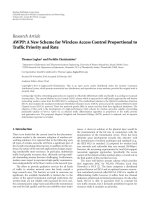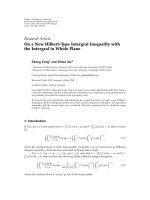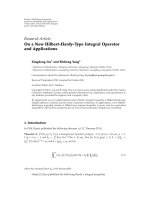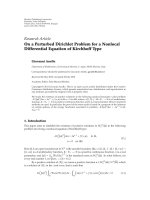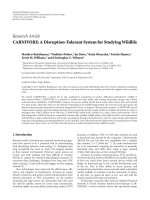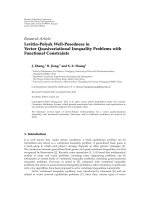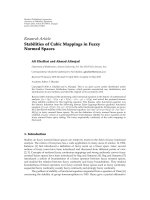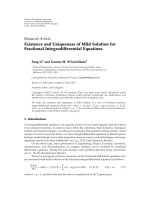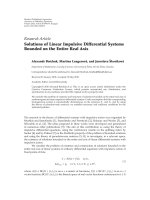Báo cáo sinh học: " Research Article Appling a Novel Cost Function to Hopfield Neural Network for Defects Boundaries Detection of Wood Image" pptx
Bạn đang xem bản rút gọn của tài liệu. Xem và tải ngay bản đầy đủ của tài liệu tại đây (1.59 MB, 8 trang )
Hindawi Publishing Corporation
EURASIP Journal on Advances in Signal Processing
Volume 2010, Article ID 427878, 8 pages
doi:10.1155/2010/427878
Research Article
Appling a Novel Cost Function to Hopfield Neural Network for
Defects Boundaries Detection of Wood Image
Dawei Qi, Peng Zhang, Xuefei Zhang, Xuejing Jin, and Haijun Wu
College of Science, Northeast Forestry University, Harbin 150040, China
Correspondence should be addressed to Dawei Qi,
Received 31 December 2009; Revised 14 April 2010; Accepted 13 May 2010
Academic Editor: Jo
˜
ao Manuel R. S. Tavares
Copyright © 2010 Dawei Qi e t al. This is an open access article distributed under the Creative Commons Attribution License,
which permits unrestricted use, distribution, and reproduction in any medium, provided the original work is properly cited.
A modified Hopfield neural network with a novel cost function was presented for detecting wood defects boundary in the image.
Different from traditional methods, the boundary detection problem in this paper was formulated as an optimization process
that sought the boundary points to minimize a cost function. An initial boundary was estimated by Canny algorithm first. The
pixel gray value was described as a neuron state of Hopfield neural network. The state updated till the cost function touches the
minimum value. The desig ned cost function ensured that few neurons were activated except the neurons corresponding to actual
boundary points and ensured that the activated neurons are positioned in the points which had greatest change in gray value. The
tools of Matlab were used to implement the experiment. The results show that the noises of the image are effectively removed, and
our method obtains more noiseless and vivid boundary than those of the traditional methods.
1. Introduction
X-ray wood nondestructive testing is an effective method
for accessing to internal information of wood. Comparing
with other conventional wood nondestructive testing, such as
appearance judgment, acoustic emission testing, ultrasonic
testing, microwave testing, and stress wave testing, this
method can acquire distinct wood internal structure images
by an X-ray imaging system. Through the wood images, the
positions of wood defects can be easily identified; the scales
of the defects can be roughly estimated. Furthermore, we can
make use of computer technology to automatically extract
wood defects information from the images for automati-
cally identifying defects characteristics such as areas, types,
and severity, which can help making the optimal sawing
solution. However, extracting accurate defects information
depends on the accurate boundary detection. There are many
edge detection algorithms. Most previous edge detection
algorithms used first-order derivative operators such as the
Sobel edge operator [1, 2], the Roberts edge operator, and
the Prewitt edge operator [3]. If a pixel point is on the
boundary, its neighborhood will be a zone of transition.
The Laplacian operator [4] is a second-order derivative
operator and is used to detect boundary at locations of the
zero crossing. The Canny operator [5, 6], another gradient
operator, is used to determine a class of optimal filter for
different types of boundaries. All these operators detect
boundary points by gray gradient change of the image pixels
in the neighborhood; the disadvantage of these methods are
sensitive to noise.
Comparing with traditional edge detection methods,
Hopfield neural network, which regarded an edge detection
process as an optimization process, has been applied in
the field of the low-level image processing of boundary
detection in the recent years. Chao and Dhawan [7] used
a Hopfield neural network to perform edge detection on a
gray-level image. The results were found to be comparable
to a Sobel operator on gray-level noisy images. Chang
[8] applied Contextual-based Hopfield neural network to
medical image e dge detection and designed the specific
energy function for the medical images. The results showed
that the method can obtain better edge points than the
conventional methods. Active contour model (Snake) [9]was
used in image processing these years [10–13]. Zhu and Yan
[10] attempted to combine Hopfield neural network with
active contour model for brain image boundary detection.
2 EURASIP Journal on Advances in Signal Processing
That method showed the results comparable to those of
standard “snakes-” based algorithms, but it requires less
computing time.
In this paper, we presented a novel approach to auto-
matically detect wood defects boundaries using a modified
Hopfield neural network with a specific cost function
designed for wood defects image. The boundary detection
problem in this paper was regarded as an optimization
process that sought the boundary points to minimize
a cost function. Hopfield neural network was used as
computational networks for solving optimization problems.
Because of its highly interconnected structure of neurons,
the network was not only very effective in computational
complexity, but also very fault tolerant. In consideration of
the accuracy of the detection, an initial boundary must be
estimated before using the Hopfield neural network. Every
pixel in the image with an initial boundary was represented
by a neuron which was connected to all other neurons but
not to itself. The image was considered as a dynamic system
which was completely depicted by a cost function. T he states
of the neurons updated according to the cost function till
the convergence. Then, the result image was given by the
states of the neurons. The tools of Matlab were applied to
implement the experiment in this paper. The results showed
that our method can obtain more continued and more
accurate boundary points than the traditional methods of
boundary detection.
The remainder of this paper is organized as follows. In
Section 2, a basic imaging principle of X-ray and a wood
nondestructive detection imaging system are described. A
Hopfield neural network theory and its application in solving
optimization problems are illustrated in Section 3. Section 4
discusses how to implement the boundary detection algo-
rithm using a Hopfield network. This section is divided into
four phases. We first discuss how to initiate defects bound-
aries, then how to map the boundary detection problem into
a Hopfield neural network, and then a novel cost function
for wood defects boundaries detection is described. Finally,
we il lustrate the summary of the algorithm. In Section 5,
experimental results and a discussion are given. We illustrate
a conclusion and a perspective in Section 6.
2. X-Ray Wood Nondestructive
Detection Theory
X-ray detection method has been widely applied in the
field of wood nondestructive detection in recent decades. As
the major application way using X-ray, wood defects image
was acquired first by an X-ray image system. Then, wood
defects and other internal structure features were detected by
subsequent evaluation methods.
2.1. Basic Imaging Principle of X-Ray. X-ray is a kind of
electromagnetic wave which has shorter wavelength than
visible lights. It can penetrate a certain thick opaque body.
After penet rating the body, the intensity of X-r ay is related
to the property and thickness of the body and energy of
the X-ray. For a monochromatic narrow beam X-ray (w hich
I
0
X-ray
T
I
Figure 1: Attenuation diagram of X-ray imaging law.
has a single wavelength), when it penetrates a thin part of
homogeneous substance which part has a thickness as ΔT,
the decay intensity of the X-ray is proportional to incident
ray intensity and thickness of the substance, as ΔT
=−μΔT.
Therefore, after the X-ray has intensity as I
0
, penetrating
homogeneous substance has a thickness as T, the intensity
of the X-ray is
I
= I
0
e
−μT
,(1)
where, I
0
is the intensity of incident ray, I is the intensity
of transmitted ray, T is the thickness of the substance, and
μ is the attenuation coefficient. It is the basic attenuation
principle of monochromatic narrow X-ray [14]. An atten-
uation diagram of X-ray imaging law is shown in Figure 1.
In the practical testing, the X-ray from the source is a broad
beam and continuous spectrum ray, which includes different
energy photons, so the attenuation formula is complex.
The attenuation coefficient of broad beam and continuous
spectrum ray changes with increasing of thickness of the
penetrated substance. When the thickness gets a threshold
value, the attenuation coefficientgetsnearlyafixedvalue.In
this case, the continuous spectrum ray can be approximately
regarded as monochromatic ray.
2.2. X-Ray Wood Nondestructive Detection Imaging System.
The block diagram of X-ray wood nondestructive detection
imaging system is shown in Figure 2. The system used in our
experiment is capable of producing wood defects images. The
log will be placed between the X-ray source and the image
intensifier. The X-ray source gives off the X-ray which will be
absorbed partly by the wood material when it penetrates the
objects. Absorption quantity is related to the types and the
density of log defects. The attenuation of X-ray in the logs
reduces the energy, reflected in different degrees of activating
the same image intensifier screen. The visual information
of image intensifier is transmitted to a computer by a CCD
camera. The digital signals transmitted by the A/D converter
circuit from the simulation signals are deposited in the image
storage system for the wood defects image detection.
3. Hopfield Neural Networks
3.1. Basic Theory of Hopfield Neural Networks. The Hopfield
neural network is one of the most famous artificial neural
network models. As a recurrent neural network, it is
constructed from a single layer of neurons, every of which
has feedback connections to all other neurons, but not to
itself. Figure 3 shows a diagram of a Hopfield neural network
structure with four neurons.
EURASIP Journal on Advances in Signal Processing 3
Rotation
Log specimenCCD camera
Image intensifier Rotating plate
X-ray source
Figure 2: The block diagram of X-ray wood nondestructive
detection imaging system.
z
−1
z
−1
z
−1
z
−1
Neuron
z
−1
Unit delay operator
Figure 3: The diagram of a Hopfield neural network with four
neurons.
EveryneuroninaHopfieldneuralnetworkhascompu-
tational capabilities, which can process an input and give
a relevant output. If the ith neuron is described by two
variables: its input u
i
and its output v
i
. The output is the
state which is computed by a given activation function f .The
transformation is described as
v
i
= f
(
u
i
)
. (2)
In a discrete model, v
i
is a discrete variable with a value of
zero or one.
The input u
i
of the ith neuron is related to the weighted
sum of other neurons and their corresponding weights
which was described as an interconnection of strength. The
interconnection of strength between the ith neuron and the
jth neuron is represented by T
ij
. For ensuring the network
convergence, the interconnective strengths are constrained to
be symmetrical, which means that T
ij
= T
ji
. In addition,
each neuron has a bias of I
i
fed to its input. The input, or
the current state of the ith neuron, is updated by a function
described as
u
i
=
N
j
/
= i
T
ij
v
j
+ I
i
. (3)
In a Hopfield neural network, a neuron can not only be
used for an input neuron, but also an output neuron. Every
Hopfield neural network has a so-called cost function (or an
energy function), which is used for measuring stability of a
Hopfield neural network. Signals were circularly tr ansmitted
in the whole network. The operation course can be regarded
as a recovered and strengthened processing for an input
signal. In the course, the network approach gradually to a
stable state when the cost function is minimized. If a problem
can be mapped to the task of minimizing a cost function, the
Hopfield neural network will be implemented to obtain an
optimal (or near optimal) solution.
3.2. Hopfield Neural Networks for Solving Optimization Prob-
lem. Hopfield neural networks have been used successfully
in solving optimization problems such as the traveling
salesman problem (TSP) [15–17]. In recent years, take
advantage of their optimization computation capabilities,
Hopfield neural networks were applied in image processing
[18–20]. Mapping a practical problem to an energy function
is a key step for Hopfield neural networks to solve optimiza-
tion problems. The basic form of the energy function was
described in the literature [21]as
E
=−
1
2
N
i=1
N
j=1
T
ij
v
i
v
j
−
N
i=1
I
i
v
i
. (4)
The general steps for solving optimization problems are
described as follows.
First of all, an objective function of a problem should
be illustrated by the penalty function method. The designed
optimization problem is
min ϕ
(
v
1
, v
2
, , v
N
)
,
restriction: p
i
(
v
1
, v
2
, , v
N
)
≥ 0, i = 1, 2, , k,
(5)
k is the number of the restriction. The objective function is
J
= ϕ
(
v
1
, v
2
, , v
N
)
+
k
i=1
λ
i
F
p
i
(
v
1
, v
2
, , v
N
)
(6)
λ
i
is a sufficiently large constant. λ may have different
dereferencing. By comparing each term in (5) with the
corresponding terms in (6), we can determine the network
parameters, the inter-connective strength T
ij
, and the bias
I
i
of each neuron. Secondly, the dynamic equation of the
network is written out. For a continuous network, the
dynamic equation can be calculated by
du
i
dt
=−k
i
∂E
(
v
1
, v
2
, , v
N
)
∂v
i
, k
i
> 0. (7)
For a discrete network, the dynamic equation can be
calculated by
Δu
i
=−k
i
∂E
(
v
1
, v
2
, , v
N
)
∂v
i
, k
i
> 0. (8)
After obtaining the dynamic equation, the original inputs
can drive the network till it achieves a stable state. Then, the
optimization result is worked out.
4 EURASIP Journal on Advances in Signal Processing
(a) An original wood image (b) Processed images by Canny algorithm (c) The image that (a) merged (b)
Figure 4: An original wood image and processed wood images.
4. Hopfield Neural Networks for Wood Defects
Boundary Detection
The boundary detection problem in this paper was regarded
as an optimization process that sought the boundary points
to minimize a cost function. Hopfield neural network was
used as computational networks for solving optimization
problems.
4.1. Initiate Boundary. An initial boundary must be esti-
mated before using our Hopfield neural network boundary
detection m ethod. The Canny detector w as selected to
implement the initiation. The Canny detector is the most
powerful edge detector provided by function edge. In the
Canny algorithm, an image is smoothed using a Gaussian
filter with a specified standard deviation, σ, to reduce noise.
The local gradient, g(x, y)
= [G
2
x
+G
2
y
]
1/2
, and edge direction,
α(x, y)
= tan
−1
(G
y
/G
x
), are computed at each point. An
edge point is defined to be a point whose strength is locally
maximum in the direction of the gradient. The algorithm
then tracks along the top of these ridges and sets to zero all
pixels that are not actually on the ridge top so as to give a
thin line in the output. Finally, the algorithm performs edge
linking by incorporating the weak pixels that are 8-connected
to the strong pixels. Figure 4(b) shows the processed wood
defects images by Canny algorithm. Figure 4(a) is an original
wood image with a defect of crack. Figure 4(c) shows the
image that Figure 4(a) merged Figure 4(b).Effective edge
detection can be implemented using the Canny algorithm.
We can get a good detection result, less noise, and single lines.
However, the edge points do not exactly match the actual
boundary of the crack, while the edge can b e regarded as the
initiate boundary of the Hopfield neural network boundary
detection.
4.2. Boundary Detection with a Novel Cost Function. Once
we have found the initial boundary of a defect in a wood
image, we determine an approximate region where the actual
boundary is most likely to be located. A slight adjustment
can be made to seek the actual boundary which will be
implemented by a Hopfield neural network.
To design such a neural network with an energy function
for an entire image is impossible a nd impractical. However,
we noticed that the influence is small between two distant
elements. Thus, a small window is applied to the image. The
neurons inside the window are fully connected to each other.
The correlation between the central element and the element
outside the window can be ignored without affecting the final
result [22].
In this M
× N window, every pixel in the image is repre-
sented by a neuron. As shown in Figure 5, a two-dimensional
(2D) binary Hopfield neural network is constructed. All the
initiate boundary points estimated by the Canny operator
are mapped to the 2-D network. The number of rows equals
the number of rows of initial boundary image, while the
number of columns equals the number of columns of initial
boundary image. Each neuron is denoted as a point (i, j),
where 1
≤ i ≤ N and 1 ≤ j ≤ M. A binary output, 0
(for resting) or 1 (for activate), is assigned to each neuron
representing the absence or presence of boundary elements.
According to (4), we can define the energy function of the
2-D Hopfield neural network as
E
=−
1
2
N
i=1
M
j=1
N
k=1
M
l=1
T
i, jk,l
v
i, j
v
k,l
−
N
i=1
M
j=1
I
i, j
v
i, j
,(9)
where v
i, j
is the binary state of the neuron in row i and
column j, T
i, jk,l
is the interconnection weight between the
neuron in row i and column j and the neuron in row k and
column l.Aneuron(i, j) in the network receives weighted
inputs T
i, jk,l
v
k,l
from the neuron (k, l) and a bias input I
i, j
from outside. The total input to neuron (i, j)iscomputedas
u
i, j
=
N
k=1
M
l=1
T
i, jk,l
v
k,l
+ I
i, j
. (10)
Theoutputofeachneuroniscomputedas
v
i, j
= f
u
i, j
, (11)
and the activation function f in the network is defined by
f
u
i, j
=
⎧
⎨
⎩
1ifu
i, j
>θ
0 otherwise.
(12)
EURASIP Journal on Advances in Signal Processing 5
Image
Crack
log
A pixel A neuron
Hopfield
neural network
Figure 5: The diagram of the relationship between the wood image
and the Hopfield neural network structure. Every pixel in the left
image is represented by a neuron in the right network structure.
The states of the neurons corresponding to the initial
boundary points are activated. As the network is running, the
operating rule drives the network towards to the direction
of minimizing the energy function, while the neurons rep-
resenting the actual boundary points are activated gradually.
Therefore, the energy function should be designed to meet
that the energy of the network is minimum when the neurons
corresponding to the actual boundary points are activated.
An objection function meeting the above conditions are
described as
E
= α
m
i=1
⎛
⎝
n
j=1
v
i, j
−
n
j=1
a
i, j
⎞
⎠
2
+ β
m
i=1
n
j=1
v
i, j
G
i, j
− G
i, j+1
+
G
i, j
− G
i, j−1
,
(13)
where v
i, j
is the output of the neuron in row i and column
j, a
i, j
is the initial value of the neuron in row i and column
j. G
i, j
is the gray value of the original wood defects image.
α and β are constant coefficients.
The first term of the energy function ensures that fewer
neurons are activated except the neurons corresponding to
the actual boundary points in each row. The second term
ensures that the ac tivated neurons are positioned in the
points which have greatest change in gray value.
By expanding (13) and comparing each term with the
corresponding terms in (9), we can determine the network
parameters, the inter-connective weights T
i, jk,l
, and the bias
inputs I
i, j
as
T
i, jk,l
=−2αδ
i,k
,
I
i, j
= 2α
n
l=1
a
i,l
− β
v
i, j
G
i, j
− G
i, j+1
+
G
i, j
− G
i, j−1
,
(14)
where δ
i, j
= 1ifi = j and zero otherwise. Once the
parameters T
i, jk,l
and I
i, j
are obtained using (14), each
neuron can evaluate and adjust its state according to (10)and
(12).
Figure 6: Original wood image.
Once the initial state of the neurons has been set,
the Hopfield neural network begins to work continuously
until the energy function of the network stops decreasing.
Through the network evolutions, the optimal (or near
optimal) boundary points are detected. T he position of these
activated neurons indicates the detected boundary locations.
4.3. Summary of the Algorithm. The algorithm of wood
defects boundary detection using the Hopfield neural net-
work can be summarized as follows.
Step (1) Set the initial state of the neurons based on the
initial boundary points which is detected by the Canny edge
detection algorithm.
Step (2) Calculate the input of each neuron, u
i, j
, using
(10).
Step (3) Calculate the output of each neuron, v
i, j
, using
(11).
Step (4) Check the state of neurons; if the state does not
change comparing with the last state, stop; otherwise, go back
to step (2).
Step (5) The final states of neurons are the output result
of the network, which represent the final boundary points.
5. Experimental Results and Discussion
The purpose of our boundary detection approach is to detect
boundaries of wood defects in an image and separate it
from normal wood structure. Once isolated, the detected
defect can be further processed for recognition of defect type
and other defect characteristic. To show that the proposed
method have good capability of boundary detection, the pro-
posed method is compared with the conventional methods
such as Sobel edge operator, Roberts edge operator, Prewitt
edge operator, Laplacian operator, and Canny operator.
Matlab is a high-level technical computing language.
We can solve technical computing problems faster than
with traditional programming languages such as C and
C++. It has a toolbox of image processing which have
some traditional image processing functions such as Sobel,
Roberts, Prewitt, Laplacian, and Canny. We can conveniently
implement the traditional image processing methods by
some simple commands. M-files are macros of Matlab
commands that are stored as ordinary text files. An M-file can
6 EURASIP Journal on Advances in Signal Processing
Figure 7: Image after edge detection using Sobel operator.
Figure 8: Image after edge detection using Roberts operator.
be either a function with input and output variables or a list
of commands. All macros of image processing commands in
Matlab are stored in M-files. We can program the proposed
commands using M-files to implement some works of image
processing including the Hopfield neura l network method.
A computer program coded by M-files of Matlab7.0 was
used to implement the proposed method. The values of the
parameters α and β were determined by the experiment. The
value α was set to 0.5, while the value of β was set to 0.05. The
initial b oundary points were estimated using the Canny edge
algorithm, and the result image was shown in Figure 4(b).
The conventional methods were implemented by the image
processing toolbox of Matlab7.0. The original wood images
used for evaluating the method were acquired from the X-
ray wood nondestructive detection imaging system. Figure 6
shows an original X-ray wood image with a crack on it.
Figures 7, 8 , 9, 10,and11 show separately the boundary
detection images using Sobel edge operator, Roberts edge
operator, Prewitt edge operator, Laplacian operator, and
Canny operator. Figures 12, 13,and14 show separately the
boundary detection images using our method with different
thresholds of θ which are separately
−0.006, −0.005, and
−0.004.
Comparing with conventional boundary detection meth-
ods, this approach converted a boundary problem to an
optimization process that seeks the boundary points to
minimize a cost function. The gray value of image pixel was
described as the neuron state of Hopfield neural network.
The state updated till the cost function touches the minimum
Figure 9: Image after edge detection using Prewitt operator.
Figure 10: Image after edge detection using LoG operator.
Figure 11: Image after edge detection using Canny operator.
Figure 12: Image after boundary detection using our method with
threshold of
−0.006.
EURASIP Journal on Advances in Signal Processing 7
Figure 13: Image after boundary detection using our method with
threshold of
−0.005.
Figure 14: Image after boundary detection using our method with
threshold of
−0.004.
value. The final states of neurons were the result image
of boundary detection. Taking advantage of the collective
computational ability and energy convergence capability of
the Hopfield network, the noises will be effectively removed.
The experimental results showed that our method can obtain
more noiseless and more vivid boundary points than the
traditional methods of boundary detection.
6. Conclusion
An X-ray imaging technique was applied in wood nonde-
structive detection. Through wood images acquired by this
technique, the wood defects information such as locations,
scales, and types was visual. The detected defects can be
further processed for recognition of defects types and other
defects characteristics.
Hopfield neural network was applied in the boundary
detection of wood images. We designed a novel cost funct ion
for a Hopfield neural network to detect a defect boundary
as solving an optimization problem. After the boundary
initiation using Canny edge algorithm, a slight adjustment
can be made to seek the actual boundary which will be
implemented by a Hopfield neural network with the cost
function. Those points that decreased the network energy
were detected as boundary points. Taking advantage of
the collective computational ability and energy convergence
capability of the Hopfield neural network, the experiment
received a good result. As shown in the Figures 6–14, the
method based on Hopfield neural network in detecting
boundary of wood defects was effective; the noises were
effectively removed. We can get a more noiseless and vivid
wood defect boundary. Thus, a promising method of wood
boundary detection based on Hopfield neural network with
a novel cost function is provided. All the courses of image
processing and building a Hopfield neural network in this
paper were implemented using the tools of Matlab. The tools
of Matlab are well done in the study of images.
References
[1] L. S. Davis, “A survey of edge detection techniques,” Computer
Graphics Image Processing, vol. 4, pp. 248–270, 1975.
[2] D S. Lu and C C. Chen, “Edge detection improvement by ant
colony optimization,” Pattern Recognition Letters, vol. 29, no.
4, pp. 416–425, 2008.
[3] R. C. Gonzalez, R. E. Woods, and S. L. Eddins, Digital Image
Processing Using MATLAB, Publishing House of Electronics
Industry, Beijing, China, 2004.
[4] R. C. Gonzalez and R. E. Woods, Digital Image Processing,
Publishing House of Electronics Industry, Beijing, China, 2nd
edition, 2002.
[5] J. Canny, “Computational approach to edge detection,” IEEE
Transactions on Pattern Analysis and Machine Intelligence, vol.
8, no. 6, pp. 679–698, 1986.
[6] X. Xu, Z. Yang, and Y. Wang, “A method based on rank-
ordered filter to detect edges in cellular image,” Pattern
Recognition Letters, vol. 30, no. 6, pp. 634–640, 2009.
[7] C. H. Chao and A. P. Dhawan, “Edge detection using Hopfield
neural network,” in Proceedings of Conference on Applications
of Artificial Neural Networks, vol. 2243, pp. 242–251, 1994.
[8] C Y. Chang, “A contextual-based Hopfield neural network
for medical image edge detection,” in Proceedings of the IEEE
International Conference on Multimedia and Expo (ICME ’04),
pp. 1011–1014, June 2004.
[9] M. Kass, A. Witkin, and D. Terzopoulos, “Snakes: active
contour models,” International Journal of Computer Vision,
vol. 1, no. 4, pp. 321–331, 1988.
[10] Y. Zhu and H. Yan, “Computerized tumor boundary detection
using a hopfield neural network,” IEEE Transactions on
Medical Imaging, vol. 16, no. 1, pp. 55–67, 1997.
[11] A. K. Hamou and M. R. El-Sakka, “Optical flow active
contours with primitive shape priors for echocardiography,”
EURASIP Journal on Advances in Signal Processing, vol. 2010,
Article ID 836753, 10 pages, 2010.
[12] Y. Zheng, G. Li, X. Sun, and X. Zhou, “A geometric active
contour model without re-initialization for color images,”
Image and Vision Computing, vol. 27, no. 9, pp. 1411–1417,
2009.
[13] Y. Yang and X. Gao, “Remote sensing image registration
via a ctive contour model,” AEU—International Journal of
Electronics and Communications, vol. 63, no. 4, pp. 227–234,
2009.
[14] Z. Liu, Modern Ray Detection Technology, China Standard
Press, Beijing, China, 1999.
[15] J. F. R
¨
oßler and W. H. Gerstacker, “On the convergence
of iterative receiver algorithms utilizing hard decisions,”
EURASIP Journal on Advances in Signal Processing, vol. 2009,
Article ID 803012, 8 pages, 2009.
8 EURASIP Journal on Advances in Signal Processing
[16] U P. Wen, K M. Lan, and H S. Shih, “A review of Hop-
field neural networks for solving mathematical programming
problems,” European Journal of Operational Research, vol. 198,
no. 3, pp. 675–687, 2009.
[17] J. J. Hopfield and D. W. Tank, “’Neural’ computation of
decisions in optimization problems,” Biological Cybernetics,
vol. 52, no. 3, pp. 141–152, 1985.
[18] G. Pajares, M. Guijarro, and A. Ribeiro, “A Hopfield Neural
Network for combining classifiers applied to textured images,”
Neural Networks, vol. 23, no. 1, pp. 144–153, 2010.
[19] R. Cierniak, “A 2D approach to tomographic image recon-
struction using a Hopfield-type neural network,” Artificial
Intelligence in Medicine, vol. 43, no. 2, pp. 113–125, 2008.
[20] R. Sammouda and M. Sammouda, “Improving the perfor-
mance of Hopfield neural network to segment pathological
liver color images,” International Congress Series, vol. 1256, pp.
232–239, 2003.
[21] J. J. Hopfield, “Neurons with graded response have collective
computational properties like those of two-state neurons,”
Proceedings of the National Academy of Sciences of the United
States of America, vol. 81, pp. 3088–3092, 1984.
[22] S. Lu, Z. Wang, and J. Shen, “Neuro-fuzzy synergism to
the intelligent system for edge detection and enhancement,”
Pattern Recognition, vol. 36, no. 10, pp. 2395–2409, 2003.
